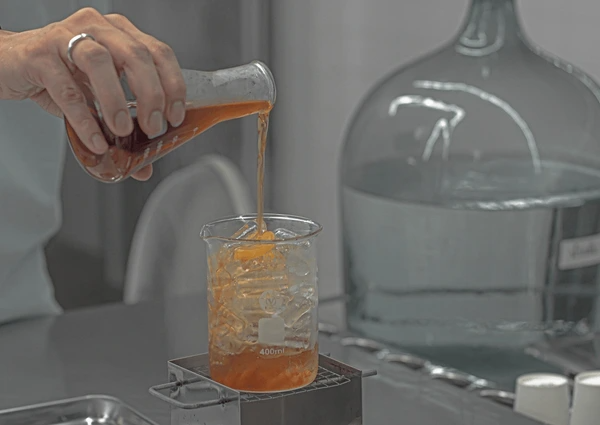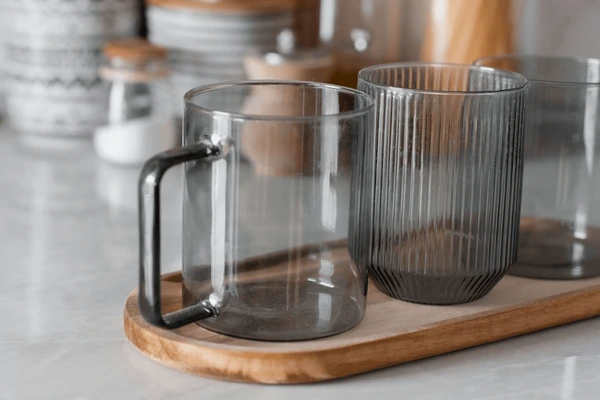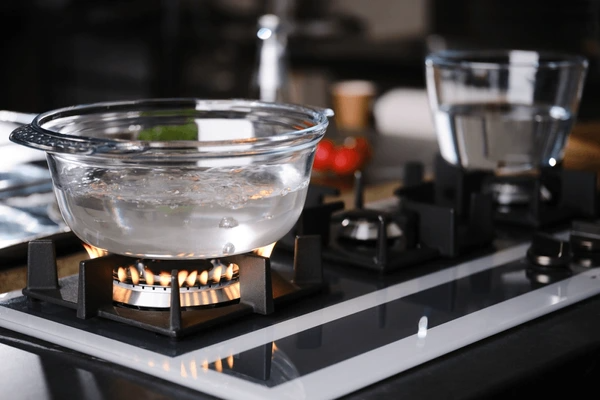
What is Borosilicate Glass?
Borosilicate glass is a type of glass that contains boron trioxide (B2O3) as a key component, along with silica (SiO2) and other oxides like aluminium oxide (Al2O3), sodium oxide (Na2O), and calcium oxide (CaO). This unique composition gives it several desirable properties, making it suitable for various applications.

Characteristics
Borosilicate glass is a type of glass with excellent properties that make it suitable for various applications, particularly in the pharmaceutical and scientific industries.
Chemical Resistance
- It exhibits high resistance to chemical attack from water, acids, alkalis, and organic solvents, making it ideal for laboratory equipment, chemical processing vessels, and pharmaceutical packaging.
- The high chemical stability of borosilicate glass is attributed to its low alkali content and the presence of boron oxide (B2O3), which enhances the glass network structure.
Thermal Properties
- It has a low coefficient of thermal expansion, allowing it to withstand rapid temperature changes without cracking or deforming.
- It has a high thermal shock resistance, typically greater than 150°C, making it suitable for applications involving direct heating or rapid cooling.
- The transition temperature and softening temperature of borosilicate glass are relatively low, facilitating easier processing and forming.
Optical Properties
- It has excellent optical properties, including high transparency and low fluorescence, making it suitable for applications in optics, photonics, and analytical instruments.
- Some compositions can be designed to absorb UV radiation, making them useful for applications such as fluorescent lamps and UV shielding.
Mechanical Properties
- Despite having a lower density than soda-lime glass, borosilicate glass exhibits good mechanical properties, including high surface hardness and scratch resistance.
- Its mechanical strength and impact resistance make it suitable for applications such as bulletproof glass, armoured vehicle windows, and high-rise building glazing.
Hydrolytic Resistance
- Borosilicate glass has excellent hydrolytic resistance, meaning it can withstand attack from aqueous solutions, including those containing acids or alkalis, making it suitable for pharmaceutical packaging.
In summary, borosilicate glass offers a unique combination of chemical resistance, thermal stability, optical clarity, mechanical strength, and hydrolytic resistance, making it an ideal material for various applications in the pharmaceutical, scientific, and industrial sectors.
Pros & Cons
Borosilicate glass is widely used in the pharmaceutical industry for manufacturing containers such as vials, ampoules, and pre-filled syringes due to its excellent properties. Here are the key pros and cons of borosilicate glass:
Pros
- Chemical Resistance: Borosilicate glass exhibits outstanding hydrolytic resistance, preventing aqueous or water-containing medicaments from attacking the glass and releasing ions that could degrade the drug. This ensures better shelf life and stability for the stored materials.
- Thermal Stability: Borosilicate glass has a low thermal expansion coefficient, high transition temperature, and high softening temperature. This makes it resistant to thermal shocks and suitable for applications involving sterilisation or heat treatments.
- Mechanical Strength: Borosilicate glass possesses good mechanical properties, such as high bending strength and hardness , making it durable and less prone to breakage during handling and transportation.
- Optical Properties: Borosilicate glass exhibits high transparency and can be formulated to have improved UV resistance , making it suitable for applications requiring optical clarity or UV exposure.
Cons
- Potential Leaching: Despite its chemical resistance, borosilicate glass can still release trace amounts of alkali ions, which may interact with and denature certain sensitive biologics like proteins. This can necessitate lyophilization (freeze-drying) for some products.
- Silicone Oil Interaction: In glass syringes, silicone oil is often used as a lubricant, but it has been implicated in the precipitation of protein solutions and other biologics. The non-uniform coating can also lead to syringe failures.
- Glass Particulates: Borosilicate glass containers are prone to breakage or degradation during manufacturing, filling, shipping, and use, which can result in glass particulates contaminating the drug product. This has led to product recalls and FDA warnings.
- Dimensional Tolerances: Glass-forming processes may not yield the tight dimensional tolerances required for some advanced delivery systems and auto-injectors.
Comparison: Borosilicate vs. Regular Glass

- Chemical Resistance: It has significantly higher resistance to chemical attack from acids and alkalis compared to regular glass.
- Thermal Stability: It has a lower coefficient of thermal expansion, allowing it to withstand rapid temperature changes better than regular glass.
- Softening Temperature: It has a higher softening temperature (around 800°C) compared to regular glass (around 600°C), making it suitable for high-temperature applications.
- Optical Properties: It exhibits better optical transmission in the visible and near-infrared regions compared to regular glass.
- Cost: Regular glass is generally less expensive to manufacture than borosilicate glass due to its simpler composition and production process.
Applications of Borosilicate Glass
Borosilicate glass has found widespread applications across various industries due to its exceptional properties. Here are some key applications:
Pharmaceutical and Laboratory Equipment
- It is extensively used for manufacturing pharmaceutical containers like vials, ampoules, and bottles. Its high chemical resistance, hydrolytic stability, and low ion release make it ideal for storing aqueous and water-based medicinal products. It is also commonly used for laboratory glassware like beakers, flasks, and test tubes owing to its thermal shock resistance and chemical durability.
Optics and Photonics
- The high transparency across a wide range of wavelengths, from UV to near-infrared, makes it suitable for optical applications. It is used in microscopes, safety cabinets, analytical instruments, and other optical devices. Its low fluorescence intensity is advantageous in life science research, minimising experimental errors when using fluorescent markers.
Automotive and Construction
- The mechanical strength, scratch resistance, and low density of borosilicate glass make it a preferred choice for automotive windshields and architectural glazing in high-rise buildings . Its high thermal resistance also allows its use in armoured vehicles and bulletproof glass applications.
Biomedical Applications
- Borosilicate bioactive glasses have gained attention for their biocompatibility, hydroxyapatite convertibility, and tissue bonding ability. They show promise in tissue engineering, tumour therapy, and drug delivery systems due to their controllable degradation and strong tissue repair and regeneration capabilities.
Reverse Osmosis and Filtration
- The microporous structure of certain borosilicate glasses makes them suitable for reverse osmosis and filtration applications. Their chemical resistance and thermal stability are advantageous in these demanding environments.
Specialty Applications
- Borosilicate glasses find niche applications in areas like induction cooking surfaces , infrared heater cover plates, and low-melting glazes for ceramics due to their tailored thermal, optical, and chemical properties.
Application Cases
| Product/Project | Technical Outcomes | Application Scenarios |
|---|---|---|
| Borosilicate Glass Vials and Ampoules | Borosilicate glass exhibits high chemical resistance, hydrolytic stability, and low ion release, making it ideal for storing aqueous and water-based medicinal products. This ensures the integrity and safety of pharmaceutical products during storage and transportation. | Pharmaceutical industry for packaging and storing liquid medications, vaccines, and other injectable drugs. |
| Borosilicate Glass Labware | Borosilicate glass has excellent thermal shock resistance and chemical durability, allowing it to withstand extreme temperatures and harsh chemicals. This makes it suitable for laboratory glassware like beakers, flasks, and test tubes, ensuring accurate and reliable results in scientific experiments. | Research laboratories, educational institutions, and industrial testing facilities for conducting chemical and biological experiments. |
| Borosilicate Glass Optics | Borosilicate glass has high transparency across a wide range of wavelengths, from UV to near-infrared, and low fluorescence intensity. These properties minimise experimental errors when using fluorescent markers and enable precise optical measurements and imaging. | Microscopes, safety cabinets, analytical instruments, and other optical devices used in life science research, medical diagnostics, and scientific instrumentation. |
| Borosilicate Glass Cookware | Borosilicate glass is highly resistant to thermal shock, making it suitable for cookware that can withstand sudden temperature changes without cracking or shattering. It is also non-porous and chemically inert, ensuring food safety and easy cleaning. | Household kitchens, professional culinary settings, and bakeware applications where thermal shock resistance and chemical inertness are essential. |
| Borosilicate Glass Solar Panels | Borosilicate glass has excellent light transmission properties and is highly resistant to thermal expansion and contraction. These characteristics make it an ideal material for solar panel covers, ensuring maximum light transmission and durability in outdoor environments. | Solar energy industry for manufacturing solar panels and other photovoltaic systems, where transparency, thermal stability, and weather resistance are crucial. |
Latest Innovations of Borosilicate Glass

Improved Hydrolytic Resistance
Recent innovations have focused on developing borosilicate glasses with improved hydrolytic resistance, making them more suitable for pharmaceutical packaging like vials and ampoules. These glasses have optimized compositions to minimize ion release when in contact with aqueous or water-containing medicaments, enhancing chemical durability.
Microporous Borosilicate Glasses
Microporous borosilicate glasses with optimized pore distributions have been developed for reverse osmosis applications. The controlled porosity allows for efficient filtration and separation processes.
Unique Fracture Behavior
The compositions have been engineered to exhibit unique fracture behavior, making them suitable for vehicle windshields and other applications requiring impact resistance. These glasses can be fusion-formed at relatively large thicknesses while maintaining their fracture properties.
Alkali Borosilicate Glasses
Alkali borosilicate glasses with specific compositions have been developed for applications like architectural windows and vehicle windows. These glasses have heat-shielding properties, low solar transmittance, high visible light transmittance, and a desirable gray color achieved by adjusting the ratio of 3-coordinated to 4-coordinated boron.
Bioactive Borosilicate Glasses
Borosilicate bioactive glasses have shown promising applications in the biomedical field due to their controllable degradation, hydroxyapatite convertibility, biocompatibility, and ability to bond with hard and soft tissues . These glasses have been explored for tissue repair, tumor therapy, and drug delivery.
UV-Resistant and Alkaline-Resistant Glasses
Borosilicate glasses with improved UV resistance and alkaline resistance have been developed, particularly for pharmaceutical packaging. These glasses contain specific additives like TiO2, CeO2, and Y2O3 while excluding iron compounds, resulting in better light transmission and durability.
Technical Challenges
| Improved Hydrolytic Resistance of Borosilicate Glass | Developing borosilicate glass compositions with optimised compositions to minimise ion release when in contact with aqueous or water-containing medicaments, enhancing chemical durability for pharmaceutical packaging applications. |
| Microporous Borosilicate Glasses for Filtration | Developing borosilicate glasses with controlled porosity and optimised pore distributions for efficient filtration and separation processes in reverse osmosis applications. |
| Fracture Behaviour of Borosilicate Glass | Engineering borosilicate glass compositions to exhibit unique fracture behaviour, making them suitable for applications requiring impact resistance, such as vehicle windshields. |
| Alkali Borosilicate Glasses for Windows | Developing alkali borosilicate glass compositions with specific compositions for architectural windows and vehicle windows, with properties such as heat shielding and desirable aesthetic design. |
| Neutral Borosilicate Glasses for Pharmaceuticals | Developing neutral borosilicate glasses with high chemical stability, excellent hydrolysis resistance, low crystallisation tendency, and good processing performance for pharmaceutical applications. |
To get detailed scientific explanations of borosilicate glass, try Patsnap Eureka.

